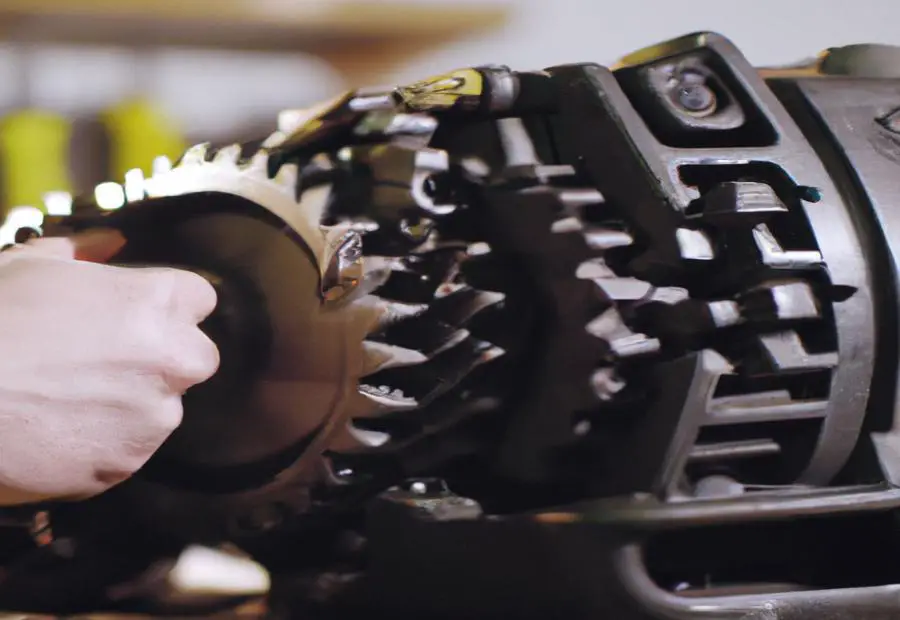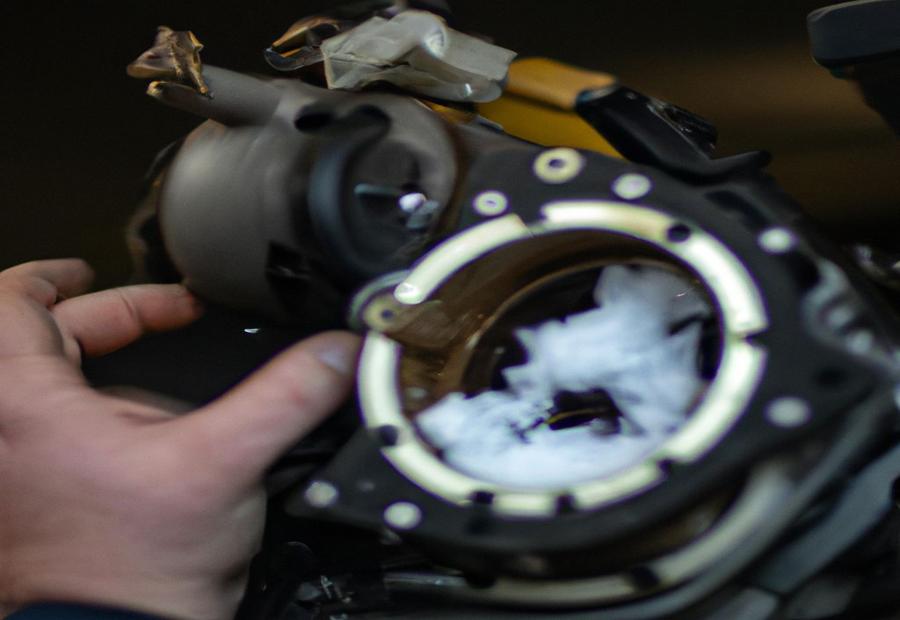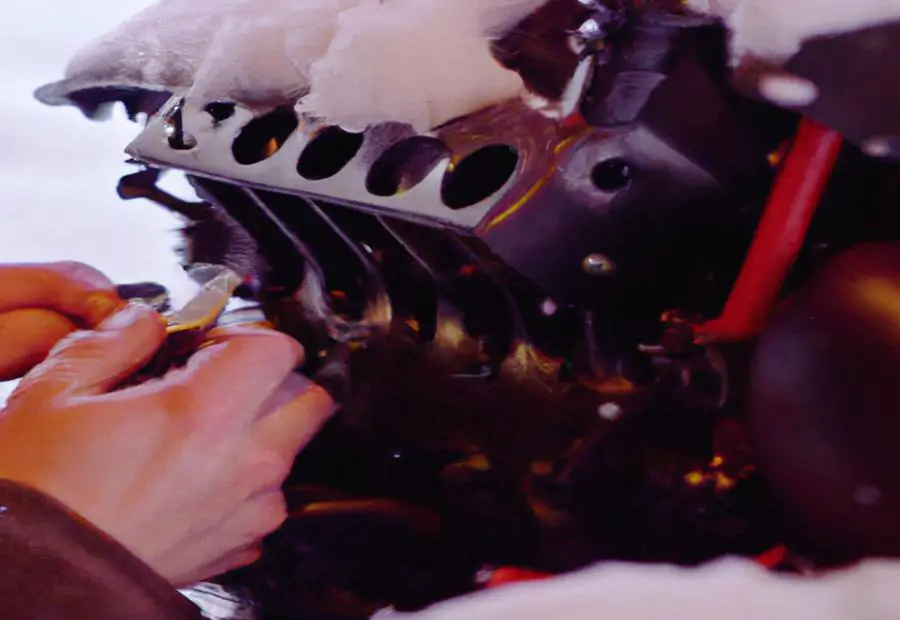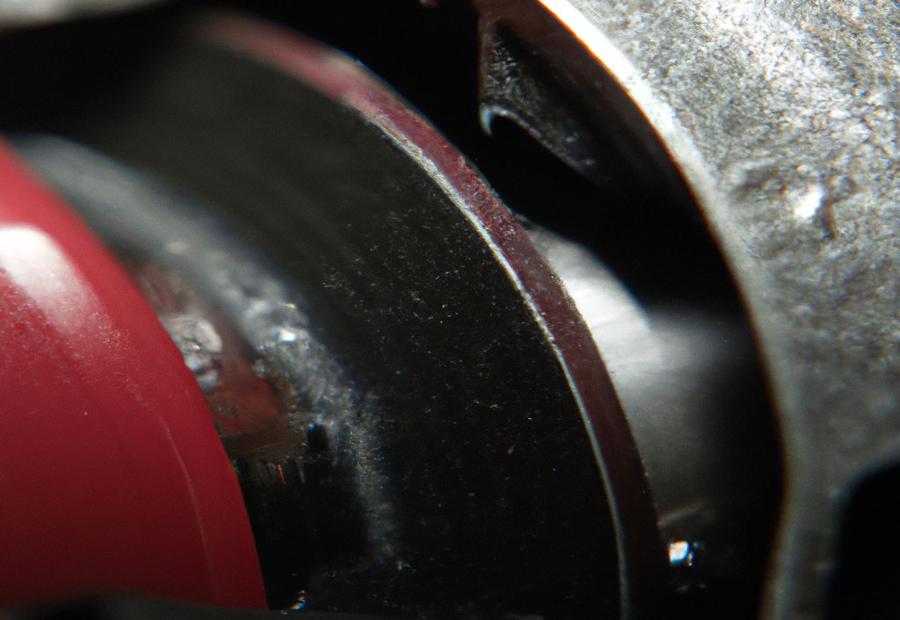GardenerHeaven.com is reader-supported. When you buy through links on our site, we may earn an affiliate commission.
.jpg)

Photo Credits: Gardenerheaven.Com by Brandon Williams
Does your snowblower surge when the choke is turned off? Don’t worry, we’ve got you covered! In this section, we’ll discuss the common problem of a snowblower surging with the choke off and why it’s crucial to address this issue. Stay tuned for expert advice on how to fix your snowblower and ensure smooth operation in the upcoming sub-sections. Let’s get your snowblower running flawlessly again!
Explanation of the problem: Snowblower surges with choke off
A snowblower surging with the choke off is a common problem. When the choke is turned off, the snowblower starts to surge or fluctuate in speed, which can be frustrating and affect its performance and efficiency.
The cause of this issue lies in the carburetor, which is responsible for mixing fuel and air for combustion. If the carburetor is dirty or faulty, it can cause an imbalance in the fuel-air mixture, leading to surging.
To diagnose the cause of the surging, you should check the components. Inspect the gas bowl for sludge, as sludge can restrict fuel flow and cause surging. If necessary, clean or replace the carburetor. Disassembling the carburetor will require tools such as screwdrivers and pliers.
To improve engine performance, you can clean or replace the carburetor. This involves stripping it down to access the internal parts and cleaning the portholes and passages with a wire brush and carb cleaner. Then, rebuild and refit the carburetor.
To prevent future carburetor issues, you can add a gas stabilizer to the gas tank. The stabilizer will help keep the fuel system clean and maintain optimal performance.
If cleaning is not enough to resolve the issue, you may need to replace the carburetor. If the surging persists after cleaning or if there is visible damage to the carburetor, you can order a compatible replacement carburetor.
Importance of addressing the issue
Addressing the snowblower surging issue is important. If not, it can cause problems like inefficient running, difficulty in starting and even damage the engine. Ignoring this issue will only make it worse and cost to repair. Understand the cause and take necessary measures to fix it. Knowing the importance of addressing the issue is key to keeping the snowblower working optimally.
Understanding the cause

Photo Credits: Gardenerheaven.Com by Terry King
When it comes to a snowblower surging with the choke off, understanding the cause is key. In this section, we’ll uncover the role of the carburetor in a snowblower and why a dirty or faulty carburetor is likely behind the problem. Stick around to learn how to fix this frustrating issue and get your snowblower running smoothly again.
Role of the carburetor in a snowblower
Looking for some answers? The carburetor in your snowblower is likely the culprit! It regulates the mix of air and fuel, vital for its operation.
When the choke is off, it controls fuel flow into the engine. But a dirty or faulty carburetor can disrupt this, leading to irregular fuel delivery and surging.
To diagnose and fix the issue, follow these steps:
- Check the gas bowl for sludge and debris.
- If present, it’s time to clean or replace the carburetor.
- Remove the carburetor following specific steps.
- Strip it down and use a wire brush and carb cleaner to clear dirt and grime from its portholes and passages.
- Rebuild and refit it with new gaskets or seals, if necessary.
Stave off future issues by adding a gas stabilizer to the gas tank. If cleaning fails to fix the problem, consider replacing the carburetor. Order a compatible one that matches your snowblower’s specs for proper fit and function.
Dirty or faulty carburetor as the likely cause of the problem
A snowblower surging with the choke off could be caused by a dirty or faulty carburetor. This device regulates the fuel and air mix needed for combustion.
Check the gas bowl for sludge. Remove it and inspect for debris and contaminants. If sludge is present, it’s likely the fuel is not filtered properly.
Remove the carburetor, using tools like wrenches or screwdrivers. Disassemble it for cleaning. Use a wire brush and carb cleaner to clean all passages and portholes. Ensure any clogs or blockages are gone. Rebuild and refit it onto the snowblower.
Add a gas stabilizer to the gas tank to prevent fuel degradation. If cleaning does not help, replace the carburetor. Severe damage or wear may mean a compatible replacement is needed.
Take steps to address a snowblower that surges with the choke off. Do regular maintenance to keep it running optimally.
Diagnosing the problem

Photo Credits: Gardenerheaven.Com by Terry Lewis
Diagnosing the problem: Unleash the full potential of your snowblower! We’ll take a closer look at checking the gas bowl for sludge, the steps to remove the carburetor for inspection, and the essential tools required for the job. Get ready to tackle the surge with confidence and bring back optimum performance to your snowblower.
Checking the gas bowl for sludge
To stop surging issues, check the snowblower’s gas bowl for sludge. Here’s how:
- Drain the gas tank.
- Find the carburetor near the engine.
- Take off the bolt that holds the gas bowl.
- Tilt the bowl and look for sludge.
- Use a clean cloth or towel to remove it.
- Tighten the bolt again.
Remember to drain the tank first. This stops you from contaminating a clean bowl.
Regularly inspecting and cleaning the gas bowl stops future surging. So, get ready to inspect and say bye-bye to carburetor troubles!
Steps to remove the carburetor for inspection
To inspect the carburetor, you must first remove it. Here’s what to do:
- Disconnect the spark plug wire for safety.
- Find the carburetor on your snowblower. It’s usually near the engine and may be covered.
- Use a wrench or socket set to loosen and take out the bolts or screws attaching the carburetor. Remember each bolt or screw for reassembly.
- Carefully remove any linkage or fuel lines connected to the carburetor. Pay attention to their position for easy reattachment later.
- Once all connections are detached, lift the carburetor away. Don’t forget any gaskets or seals.
Handle with care as improper handling could cause more damage. Be sure to check for dirt, debris, or wear that might cause surging with choke off. To clean or replace the carburetor, you must first remove it for inspection.
Tools required for the job
For the job of cleaning or replacing a snowblower’s carburetor, you’ll need a set of screwdrivers, pliers, an adjustable wrench, a carburetor cleaning solution, a wire brush, and a can of carb cleaner. These tools are a must for taking apart and putting back together the carburetor, as well as cleaning its parts.
Screwdrivers are for taking out screws which secure the carburetor. Pliers are essential for loosening hose clamps and removing fuel lines. The adjustable wrench is used to disconnect the throttle linkage from the carburetor. The carburetor cleaning solution is to soak the components and get rid of debris. A wire brush is used to scrub away grime from the portholes and passages of the carburetor. Lastly, the can of carb cleaner is for spraying into small openings and crevices that are hard to reach.
It’s important to have all these tools ready beforehand. Each one serves a purpose to make sure the removal, cleaning, and reinstallation of the carburetor are successful. Additionally, you should have a clean work area with good lighting and ventilation. This will help you see better and stop any hazardous fumes from building up during the process. With all the right tools, you can address the issue with your snowblower’s surging problem quickly.
Cleaning or replacing the carburetor

Photo Credits: Gardenerheaven.Com by Gabriel Lopez
If your snowblower is surging with the choke off, the issue may lie with the carburetor. In this section, we will focus on the cleaning or replacing of the carburetor to resolve this problem. We will discuss the process of stripping the carburetor, using a wire brush and carb cleaner to clean the portholes and passages, as well as rebuilding and refitting the carburetor. By following these steps, you can ensure your snowblower runs smoothly without any surges.
Process of stripping the carburetor
To fix a snowblower surging with the choke off, stripping the carburetor is key. Follow these steps:
- Start by checking the gas bowl for sludge.
- Then, disconnect fuel lines and electrical connections, plus remove mounting bolts or screws.
- You’ll need screwdrivers, pliers, wrenches, and a carb cleaner kit.
- Clean the portholes and passages with a wire brush and carb cleaner.
- Rebuild and refit all the components, too, replacing any worn-out gaskets or seals.
Stripping the carburetor helps restore optimal functioning to the snowblower – don’t worry, this isn’t a dental appointment for your snowblower!
Using a wire brush and carb cleaner to clean the portholes and passages
To address your snowblower surging with the choke off, try this!
-
Remove the carburetor and use a wire brush to scrub the portholes and passages.
-
Then, use some carb cleaner to clean and dissolve any leftover deposits.
This should optimize the performance of the carburetor.
Inspect other components too, like gaskets and seals. This can help prevent blockage and leakage.
After this, you should be able to use the snowblower without choke assistance.
So, get ready to put it all back together and give the carburetor a new lease on life!
Clean those portholes and passages with a wire brush and carb cleaner!
Rebuilding and refitting the carburetor
- Strip the carburetor down to its parts.
- Clean all the portholes and passages with a wire brush and carb cleaner.
- Rebuild and refit the carburetor back in its place.
- Prevent future problems with the carburetor by adding a gas stabilizer to the gas tank.
- If cleaning doesn’t fix the surging issue, consider replacing the carburetor.
- Make sure to order a compatible replacement that fits properly for best performance.
Regular maintenance of snowblowers is key in avoiding these issues.
Preventive measures for future carburetor issues

Photo Credits: Gardenerheaven.Com by Joshua Brown
To keep your snowblower running smoothly, it’s crucial to take preventive measures against carburetor issues. One effective step is adding a gas stabilizer to the gas tank. This simple addition can help protect the carburetor from fuel degradation and reduce the chances of surging with the choke off. So, let’s explore the importance of using a gas stabilizer and how it can save you from future carburetor headaches.
Adding a gas stabilizer to the gas tank
Protect your snowblower’s carburetor with a gas stabilizer! Follow these simple steps:
- Drain old gas: Use a siphon pump or unscrew the fuel line from the carburetor. Pour it into an approved container.
- Measure the stabilizer: Check the manufacturer’s instructions for how much to add per gallon of fuel. Don’t exceed the amount.
- Pour it in: Carefully add the stabilizer to the gas tank. Avoid spills and skin contact.
Gas stabilizers help preserve fuel quality, reducing the chance of carburetor issues. It saves time and money – start adding it today!
When to consider replacing the carburetor

Photo Credits: Gardenerheaven.Com by Willie Brown
When your snowblower consistently surges with the choke off, it might be time to consider replacing the carburetor. In this section, we’ll explore signs that indicate cleaning may not fix the issue and discuss the process of ordering a compatible replacement carburetor. Stay tuned to get your snowblower back to peak performance!
Signs that cleaning may not fix the issue
A dirty or faulty carburetor can cause a snowblower to surge when the choke is off. Cleaning the carburetor usually helps, but there are signs that it won’t.
- Continued surging? That suggests a more severe issue than cleaning can fix.
- Physical damage? Then cleaning won’t do, you’ll have to replace the carburetor.
- Excessive wear? Cleaning won’t help, you’ll need to replace the diaphragm or the whole carburetor.
- Inconsistent idle speed? Professional help or replacement is required.
- Flooding issues? Cleaning won’t work, you’ll need to repair or replace the float valve.
- No improvement? Something else is causing the surging. Get it inspected or seek professional help.
These signs mean cleaning the carburetor may not be enough. You’ll need to decide whether to clean it or go for an alternate solution. Finding the right carburetor? No Tinder needed!
Ordering a compatible replacement carburetor
When it comes to replacing the carburetor of your snowblower, it is essential to get the right match for optimal performance. A faulty carburetor can cause surging issues. To address this, you might have to replace the carburetor. Here is a guide on how you can order one:
- Identify the model and make of your snowblower. This will help you find a suitable replacement.
- Research suppliers who offer carburetors for your model. Select those with good customer reviews.
- Check compatibility. Read the product description or ask customer support for help.
- Place the order. Consider shipping and delivery times.
Keep your snowblower in top shape for snow fun!
Conclusion

Photo Credits: Gardenerheaven.Com by Nicholas Miller
In conclusion, regular maintenance is crucial for keeping your snowblower running smoothly. By following the steps outlined earlier, you can fix the issue of a surging snowblower with the choke off. Remember, proper upkeep not only ensures optimal performance but also prolongs the lifespan of your snowblower. Don’t neglect this essential task to avoid potential breakdowns and costly repairs. Keep your snowblower in top shape, and it will reliably tackle any winter storm that comes your way. Stay prepared and enjoy hassle-free snow clearing!
Importance of regular maintenance for snowblowers
Regular maintenance is essential for snowblowers. Neglecting it may lead to potential problems. The carburetor plays a vital role in optimizing fuel flow and air mixture. Sludge in the gas bowl can be an indication of carburetor issues. To diagnose, removing the carburetor may require specific tools. Cleaning or replacing the carburetor is necessary. Stripping it down allows access to its internal components. Using a wire brush and cleaner helps remove clogs. Rebuilding and refitting restores functionality. Adding a gas stabilizer can help avoid future issues. In some cases, replacing the carburetor is needed if persistent surging occurs. Ordering a compatible replacement is the best solution.
Recap of the steps to fix a snowblower that surges with choke off
To fix a snowblower that’s surging with the choke off, here’s what to do:
- Check the gas bowl for sludge. Inspect for signs of buildup. Sludge can clog the carburetor and cause surging. Clean it if found.
- Remove the carburetor. Take precautions and remove it. This will help you inspect and decide if it needs cleaning or replacement.
- Gather the tools. You’ll need screwdrivers, wrenches, pliers, and a wire brush to disassemble and clean the carburetor.
- Strip the carburetor. Carefully disassemble the parts. Also, note their position for reassembly later.
- Clean the portholes and passages. Use a wire brush and cleaner. This will remove dirt or debris that might be causing the surging.
- Rebuild and refit the carburetor. Carefully put the parts back in their original positions. Then, reattach it to the snowblower.
Note: If cleaning doesn’t help, it might indicate a more serious problem. In this case, get a compatible replacement carburetor and install it according to the manufacturer’s instructions.
Some Facts About “Snowblower Surges with Choke Off? Here’s How to Fix It!”:
- ✅ A snowblower that only runs on choke is likely caused by a dirty or faulty carburetor. (Source: https://www.lawnmowerfixed.com/snowblower-troubleshooting/snowblower-runs-better-on-half-choke-solved/)
- ✅ Cleaning or replacing the carburetor will fix the issue. (Source: https://www.lawnmowerfixed.com/snowblower-troubleshooting/snowblower-runs-better-on-half-choke-solved/)
- ✅ Stale gas can congeal inside the carburetor, causing it to become clogged and resulting in less power. (Source: https://www.lawnmowerfixed.com/snowblower-troubleshooting/snowblower-runs-better-on-half-choke-solved/)
- ✅ Applying the choke adds gas and temporarily solves the problem, but running the engine rich or lean can lead to more serious issues. (Source: https://www.lawnmowerfixed.com/snowblower-troubleshooting/snowblower-runs-better-on-half-choke-solved/)
- ✅ To fix the problem, the carburetor needs to be cleaned or replaced. (Source: https://www.lawnmowerfixed.com/snowblower-troubleshooting/snowblower-runs-better-on-half-choke-solved/)
FAQs about Snowblower Surges With Choke Off? Here’S How To Fix It!
Question 1: What is the main cause of a snowblower surging with the choke off?
Answer: The main cause of a snowblower surging with the choke off is a dirty or faulty carburetor. The carburetor may be clogged due to stale gas or debris, resulting in inconsistent fuel flow and causing the engine to surge.
Question 2: How can I identify the main jet in the carburetor?
Answer: The main jet in most carburetors can be identified as a small brass fitting with a tiny hole in the center and a slot across the surface. It is usually located in a protrusion coming down from the carb body into the float bowl.
Question 3: Can a damaged slot in the main jet cause surging issues in a snowblower?
Answer: Yes, a damaged slot in the main jet can cause surging issues in a snowblower. If the slot is damaged, it can affect the proper fuel flow and lead to irregular combustion, resulting in surging of the engine.
Question 4: What cleaning products should I use to clean the carburetor?
Answer: To clean the carburetor, you can use carb cleaner brush and carb cleaner. These products can effectively remove dirt, debris, and varnish buildup from the carburetor and its components.
Question 5: How can I prevent gas starvation and carburetor issues in the future?
Answer: To prevent gas starvation and carburetor issues in the future, it is recommended to drain the fuel tank and carburetor at the end of each season. Additionally, using a gas stabilizer in the fuel tank can help prevent fuel degradation and carburetor gumming.
Question 6: What are the potential consequences of not fixing a snowblower that runs on half choke?
Answer: If a snowblower runs only on half choke and the issue is not addressed, it can lead to various problems. These include oil contamination, crankshaft bearing damage, engine seizure, and valve damage. It is important to fix the issue promptly to avoid further damage to the snowblower’s engine.



